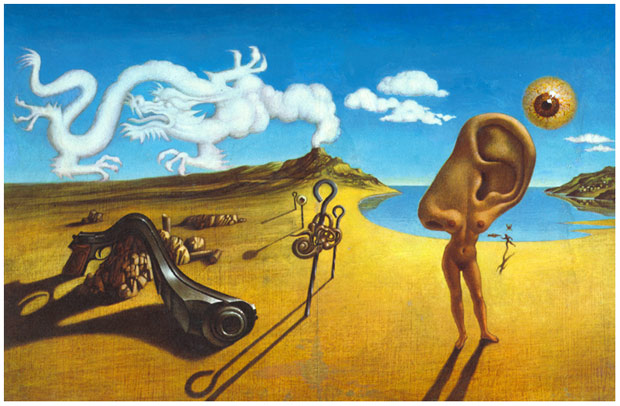
 —Lucy Fleming, Ian Fleming's niece.¹ Following Fleming's death in 1964, Glidrose Productions, publishers of the James Bond novels, planned a new book series, credited to the pseudonym "Robert Markham" and written by a rotating series of authors. After James Leasor declined an offer to write the first continuation novel, the copyright holders commissioned Kingsley Amis. Using the Robert Markham pseudonym, Amis published only one Bond novel, 1968's Colonel Sun. Amis had previously written two books on the world of James Bond, the 1964 essay The James Bond Dossier and the tongue-in-cheek 1965 release The Book of Bond, or Every Man His Own 007 (written under the pseudonym "Lt.-Col. William ("Bill") Tanner", a recurring character in the Bond novels). Numerous sources have debunked rumours that Amis was the ghost writer of The Man with the Golden Gun.
London: Jonathon Cape, 1968 Written by Robert Markham (a.k.a. Kingsley Amis) Originally Glidrose hoped to continue the Bond series by getting different authors, all under the pseudonym of "Robert Markham," to try their hand at Bond, but apparently this idea was abandoned. (Too bad - can you imagine Mickey Spillane, John Le Carre, or Robert Parker trying their hand at a Bond novel? The Dr. Seuss novel would have been awesome.) The first Markham, Kingsley Amis, was a reknowned writer (Lucky Jim) and the author of the greatest overview of Bond books ever written, The James Bond Dossier (Jonathan Cape, 1965). So Amis seemed to be the perfect candidate to continue the series. Amis: "... I still get letters from people asking if it's true that Fleming left plans for another book. In fact, it started absolutely from scratch. I supposed I should be grateful for the compliment those letters pay me in thinking that Colonel Sun is a worthy continuation of the series." Here's another quote from Amis, on the scene in which Bond is Bond is tortured through the ear: "There were people who objected to that. But I had taken a lot of care with it. I actually talked to a doctor and told him I wanted to do a torture scene unlike any other—wich was a pretty tall order. But he came up with the solution. 'Well,' he said, 'then it's got to be inside the head. That's what people are really afraid of—what they can't see." It would be the last Glidrose-based Bond novel (not counting film novelizations) for thirteen years.
A fictional bio by Ian Fleming biographer John Pearson (The Life of Ian Fleming), a friend and co-worker of Fleming's. The Authorised Biography of 007 was not commissioned by Glidrose Publications—it originated as a spoof novel for publisher Sidgwick & Jackson. However, Pearson knew Peter Janson-Smith, the Glidrose chairman, who published it. Consequently, this is the only James Bond book from Glidrose, between 1953 and 1987, not first published by Jonathan Cape, and is the only Bond novel with a shared copyright credit; Pearson is the only Bond novelist so recognized. Based upon the success of his Fleming biography, The Life of Ian Fleming (1966), MI6 instruct Pearson to write 007's biography; he is introduced to a retired James Bondâ who is in his fifties, yet healthy, sun-tanned, and with Honeychile Ryder, the heroine of Dr. No. Most of James Bond: The Authorised Biography of 007 is Bond telling his life story, including school and first MI6 missions, referring to most every novel and short story and, notably, to Colonel Sun, the Robert Markham series-continuation novel. At conclusion, as Bond rushes to another mission (contrary to mandatory retirement), John Pearson is invited to assume Ian Fleming's scribal duties, like Dr. Watson assumed with Sherlock Holmes. In fact, Glidrose Publications considered John Pearson's becoming the new, series writer; despite good reviews and sales of James Bond: The Authorised Biography of 007, nothing happened. "IS THERE A REAL JAMES BOND? JAMES BOND NOVELS BY CHRISTOPHER WOOD
The Spy Who Loved Me (1977)
Novelization: The real name of henchman Jaws is revealed: Zbigniew Krycsiwiki. Novelization: Following the killing of Fekkesh by Jaws, the novelization features a rather painful torture sequence in which electric cables are attached to Bond's genitals by KGB associates of Anya. Novelization: There is no mention of Naomi. The existence of SMERSH may be in some way due to the controversy over Thunderball, in which Kevin McClory was made aware of certain plot points of the film The Spy Who Loved Me. At one point the villain of the film was to be Ernst Stavro Blofeld and his organization SPECTRE; however, this was changed to avoid a possible lawsuit over the rights to this character, which originated from the novel Thunderball. Kingsley Amis complained that "the element of second-sight contingency planning (or negligence) that gets by in a film, indeed is very much part of the style of these films, but intrudes in a book. Your enemy has an explosive motorbike sidecar ready to launch at your car in case he's forgotten to kill you for certain and in secret a few minutes before. In case that misses, he has already aloft a helicopter fitted with jets and cannon. Your car is submersible in case you meet such a helicopter while driving on a coast road. In case you submerge your car he has a submarine waiting. In case he has you have underwater rocket-launchers." (Kingsley Amis, 'Shaken and Stirred': A Review of James Bond, The Spy Who Loved Me (1977) by Christopher Wood, "The Times Literary Supplement," 1 July 1977) James Bond and Moonraker (1979)
After the release of the novel, Glidrose Productions chose not to commission novelizations of the next few Bond films; the next film to be novelized would be Licence to Kill ten years later in 1989, owing to it not having been based on an original Fleming novel. |
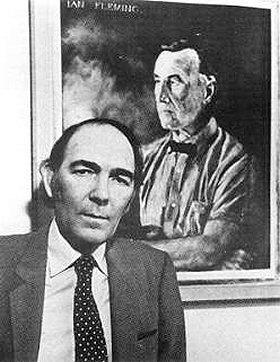 |
Between 1981 and 1996, Gardner wrote fourteen James Bond novels—even more than Fleming—as well as the novelizations of two Bond films.
LICENSE RENEWED (Richard Marek Publishers) 1981
FOR SPECIAL SERVICES (Coward, McCann & Geoghegan) 1982
ICEBREAKER (G.P. Putnam's Sons) 1983
ROLE OF HONOR (G.P. Putnam's Sons) 1984
NOBODY LIVES FOREVER (G.P. Putnam's Sons) 1986
NO DEALS, MR. BOND (G.P. Putnam's Sons) 1987
SCORPIUS (G.P. Putnam's Sons) 1988
LICENCE TO KILL (Charter - paperback only) 1989
WIN, LOSE OR DIE (G.P. Putnam's Sons) 1989
BROKENCLAW (G.P. Putnam's Sons) 1990
THE MAN FROM BARBAROSSA (G.P. Putnam's Sons) 1991
DEATH IS FOREVER (G.P. Putnam's Sons) 1992
NEVER SEND FLOWERS (G.P. Putnam's Sons) 1993
SEAFIRE (G.P. Putnam's Sons) 1994
GOLDENEYE (Boulevard—film novelization, paperback only) 1995
COLD (aka "COLD FALL" in the USA) (UK, Hodder & Stoughton; USA, G.P. Putnam's Sons) 1996
In 1989, Gardner novelized the Michael G. Wilson-Richard Maibaum screenplay for Licence To Kill â a great challenge, because his stories follow Fleming's continuity, in which Felix Leiter already had already lost an arm and a leg to a shark in the Live and Let Die novel, but recycled in the film. Resultantly, in the chapter "Lightning Sometimes Strikes Twice", the novelization requires reader acceptance of Bond dealing with Leiter's twice being maimed by a shark; however, Gardner does not attempt to reconcile the presence of Milton Krest, (who was murdered in The Hildebrand Rarity short story). It also differs from the script in places: (i) Bond uses a Walther P38K, not a Walther PPK (as in the film), because SIS had replaced it, a fact in Gardner's Bond novels. Q has an extra scene (occurring while Bond is at Sanchez's Olimpatec Meditation Institute), wherein he joins a police captain in raiding Sanchez's house. The novelisation was Gardner's first work featuring Q; before Licence to Kill, Q was heard of, not seen in his novels, having been replaced by his assistant, Ann Reilly, "Q'ute." The novelised Licence to Kill story occurs before Win, Lose or Die, wherein Bond is promoted to Captain (in the novelization and the film, Bond is still just a Commander).
His next film novelization, GoldenEye, was the second and final Bond film to be adapted to a novel by Gardner. The book closely follows the film's storyline, but Gardner added a violent sequence prior to the opening bungee jump in which Bond kills a group of Russian guards, a change that the video game GoldenEye 007 retained.
While Gardner's Bond novels were commercial successes, Gardner was ambivalent about writing novels with a character he hadn't created. In 1996, Gardner retired from writing James Bond books due to ill health and Glidrose Publications quickly chose Raymond Benson to continue the literary stories of James Bond...

JAMES BOND NOVELS BY RAYMOND BENSON
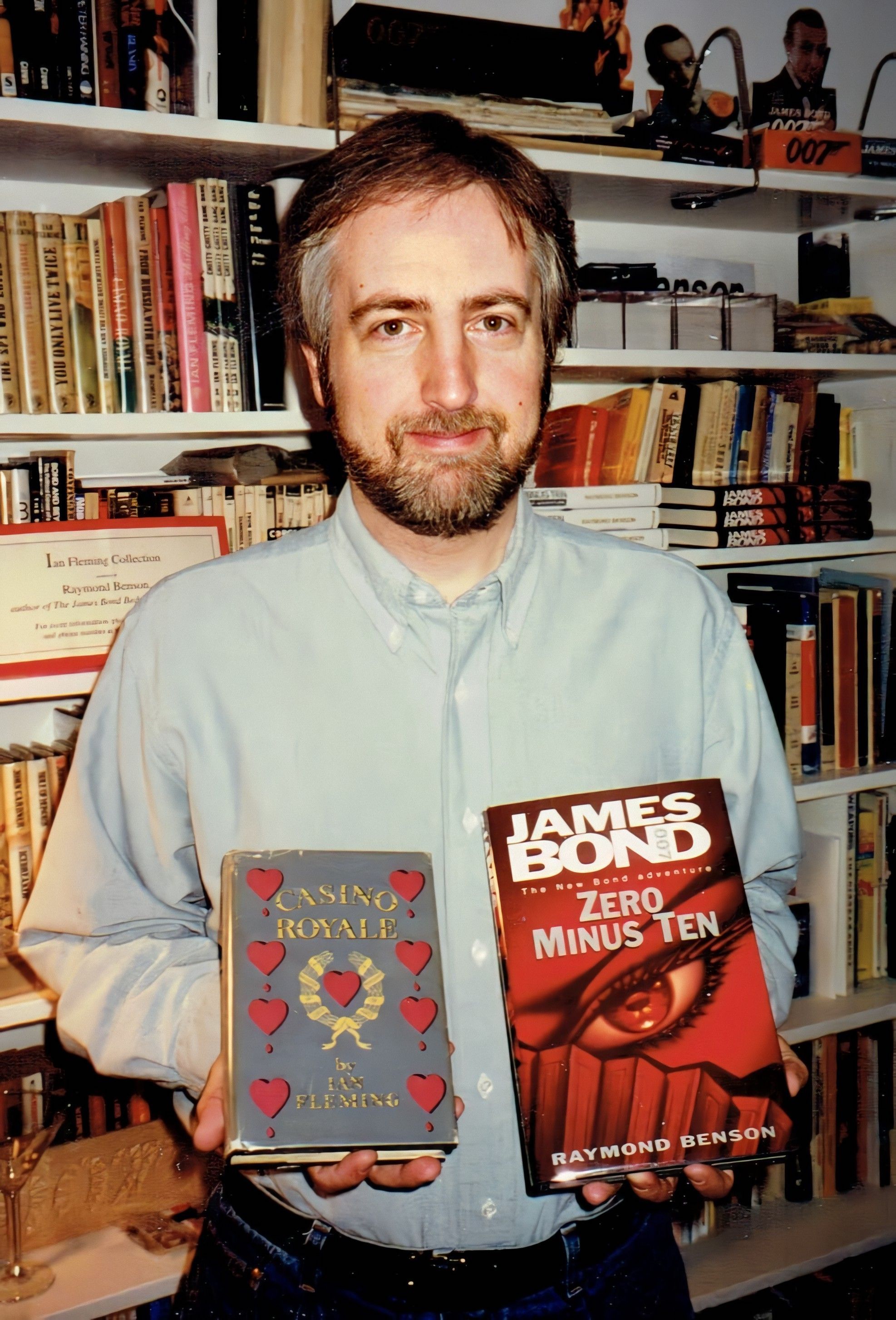 After John Gardner lost most of the Bond readership, Glidrose hired Raymond Benson, author of THE JAMES BOND BEDSIDE COMPANION, an acclaimed survey of Bondian lore, to continue the series. As a James Bond novelist, Benson was initially controversial for being American, and for ignoring much of the continuity established by Gardner. Benson had also contributed to the creation of several modules in the popular James Bond 007 role-playing game in the 1980s and several Bond video games. Benson wrote six James Bond novels, three novelizations, and three short stories.
After John Gardner lost most of the Bond readership, Glidrose hired Raymond Benson, author of THE JAMES BOND BEDSIDE COMPANION, an acclaimed survey of Bondian lore, to continue the series. As a James Bond novelist, Benson was initially controversial for being American, and for ignoring much of the continuity established by Gardner. Benson had also contributed to the creation of several modules in the popular James Bond 007 role-playing game in the 1980s and several Bond video games. Benson wrote six James Bond novels, three novelizations, and three short stories.
"Look, it was a rollercoaster of a gig. It had its ups and downs. I'm eternally grateful to the 1996 Board of Directors of Glidrose Publications (now called Ian Fleming Publications) for giving me the opportunity to do it. I didn't ask for it, you know. The man who worked as Ian Fleming's original literary agent, Peter Janson-Smith, phoned me out of the blue in late 1995 and asked if I'd be willing to give it a shot since John Gardner had decided to stop. I was flabbergasted. Peter was Chairman of Glidrose at the time and Booker PLC, a conglomerate that had its fingers in a lot of businesses, still owned it. Booker's literary side was small—it was just Glidrose and Agatha Christie Ltd. and maybe one or two other literary estates, and now they're all on their own away from Booker. About three years into my tenure as the Bond author, the Fleming family bought back the 51% of Glidrose from Booker. There had been Flemings on the Board prior to that, of course. Anyway, for seven years the job gave me the opportunity to travel the world, meet a lot of people that I never would have met, and it got my name into the publishing world. The income wasn't what people sometimes think it was—you'd be surprised how many people automatically assume I was making millions of dollars. Ha! I made the same amount of money as I would have made at a nine-to-five job. Now that it's over, I'm back to the ranks of struggling writers that have to find other ways to supplement the writing income—I teach a college course in film studies, I do speaking engagements, I look for freelance work, I even do office temp work when I'm desperate. But I must say that the relief of not having that Bond thing hanging over me is pretty nice."
—Raymond Benson, CommanderBond.net interview
"Fleming's Bond had been an Express reader; Benson's is positively red top. He's the first to have group sex - in the appallingly titled Midsummer Night's Doom - and the first to visit a prostitute, though 'she was having a good time too', apparently. Benson's final novel, The Man with the Red Tattoo, sees Bond at a YBA show, destroying an Emin-esque sculpture entitled 'Love Hurts'."
—James Harker in The Guardian, Thursday 2 June 2011
"Addicts of the genre will love it. The rest of us will remain as baffled as ever by its popularity."
—John Naughton, "London Times" critic, from his "Zero Minus Ten" review
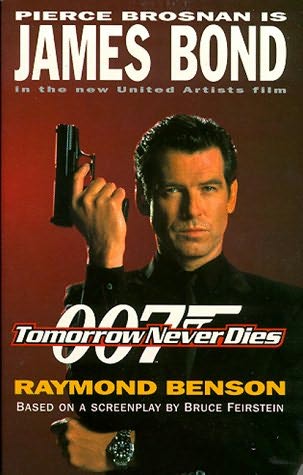 |
NOVELS ZERO MINUS TEN (1997) TOMORROW NEVER DIES (1997) Film Novelization. THE FACTS OF DEATH (1998) HIGH TIME TO KILL (1999) THE WORLD IS NOT ENOUGH (1999) Film Novelization. DOUBLESHOT (2000) NEVER DREAM OF DYING (2001) THE MAN WITH THE RED TATTOO (2002) DIE ANOTHER DAY (2002) Film Novelization. SHORT STORIES |
Benson abruptly resigned as Bond novelist at the end of 2002 to write original, non-Bond works of his own. At the same time, Ian Fleming Publications planned to focus on reissuing Fleming's original novels for the 50th anniversary of the character and re-examine its publishing strategy. The year 2003 marked the first year since 1985 that a new James Bond novel had not been published. Glidrose twice approached Lee Child, author of the Jack Reacher novels, about writing for Bond. Initially they wanted him to continue the ongoing series. They approached him again about writing the centenary novel (to commemorate the 100th anniversary of Ian Fleming's birth), but it never happened.
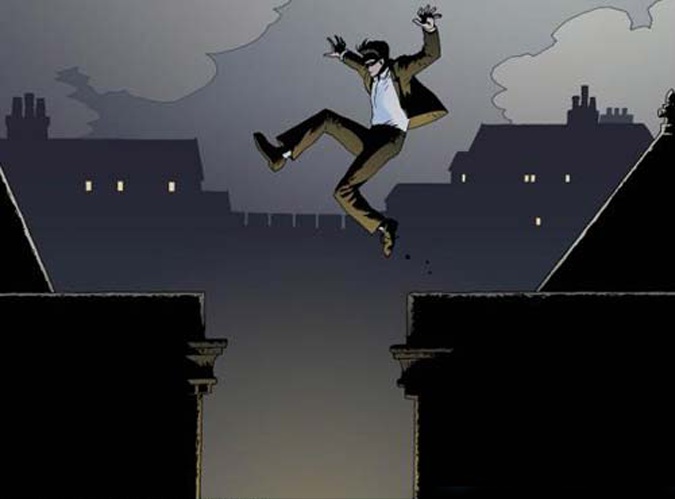
"YOUNG BOND" SERIES BY CHARLES HIGSON
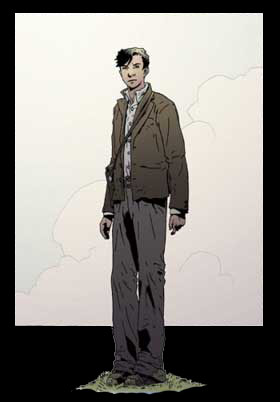 |
Then in 2005, Glidrose (now named Ian Fleming Publications, Limited) hired a novelist and comedy writer named Charlie Higson to create a new series of books about James Bond as a youth at Eton. Originally he was to write one novel, then be replaced by a different author with each book.
The reception, however, changed their plans. The first Young Bond book, "Silverfin," sold 150,000 copies in England, alone, and over half a million copies worldwide. It was championed by many literary critics and even nominated for a prestigious Edgar award. In fact, it featured some of the most suspenseful writing of the entire Bond series, which included an incredibly creepy run-in with mutated eels.
Needless to say, Higson was brought back for another book, and contracted to write three more after that. The second, "Blood Fever," was released to great fanfare and was the #1 children's book in Britain, knocking "The Lion, Witch and the Wardrobe" and the latest Harry Potter novel off their respective perches. Of course, in those books the hero isn't nearly killed after being locked away with thousands of bloodthirsty mosquitoes, so how could they hope to compete? Adults began to read as well, first for the novelty of a 13 year-old Bond who hates kissing girls, but then kept reading because the books were actually good!
The first Young Bond novel, SilverFin, was released as a graphic novel on 2 October 2008. The book was written by Charlie Higson and illustrated by renowned comic book artist Kev Walker. A Young Bond companion book, Danger Society: The Young Bond Dossier was released in October 2009. It included a new Young Bond short story, called "A Hard Man to Kill."
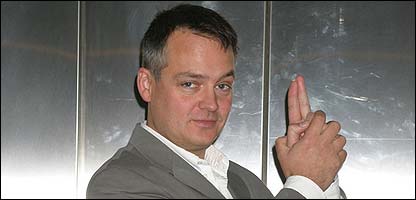 |
NOVELS SILVERFIN (2005) BLOOD FEVER (2006). DOUBLE OR DIE (2007) HURRICANE GOLD (2008) BY ROYAL COMMAND (2008) DANGER SOCIETY: THE YOUNG BOND DOSSIER (2009) GRAPHIC NOVEL & SHORT STORY |
While the Young Bond series was planned as a five book set (ending with Bond's expulsion from Eton), Higson has stated that, because of the success of the series, he will most likely be writing more Young Bond novels in the future.
THE MONEYPENNY DIARIES, by Kate Westbrook (Samantha Weinberg)
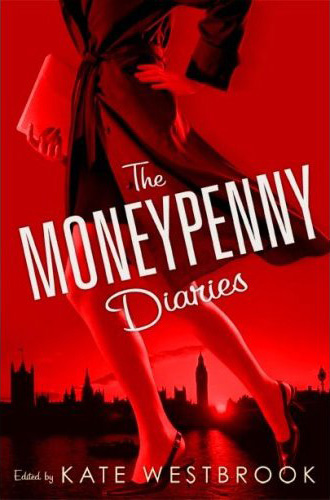 The Moneypenny Diaries is a trilogy of novels chronicling the life of Miss Moneypenny, M's personal secretary. The novels are penned by author and travel writer Samantha Weinberg, under the pseudonym Kate Westbrook, who is depicted as the book's "editor". Weinberg is the first woman to write officially licenced Bond-related literature, although Johanna Harwood had previously co-written the screenplay for Dr. No and had adapted From Russia with Love for the screen.
The Moneypenny Diaries is a trilogy of novels chronicling the life of Miss Moneypenny, M's personal secretary. The novels are penned by author and travel writer Samantha Weinberg, under the pseudonym Kate Westbrook, who is depicted as the book's "editor". Weinberg is the first woman to write officially licenced Bond-related literature, although Johanna Harwood had previously co-written the screenplay for Dr. No and had adapted From Russia with Love for the screen.
There are three volumes of the Moneypenny Diaries, all published by John Murray: the first installment of the trilogy, subtitled Guardian Angel, was released on 10 October 2005 in the UK. A second volume, subtitled Secret Servant was released on 2 November 2006 in the UK . A third volume, subtitled Final Fling was released on 10 July 2008.
The novels had originally been touted as the secret journal of a "real" Miss Moneypenny Focusing the attention on the right-hand woman of James Bond, set at various time points throughout the 1960s, and that James Bond was a possible pseudonym for a genuine intelligence officer, an idea shared by John Pearson's earlier biography, James Bond: The Authorised Biography of 007. The publisher, John Murray, admitted on 28 August 2005 that the books were a spoof after an investigation by The Sunday Times of London. Ian Fleming Publications, who had previously refused to comment as to whether the book was authorized, officially confirmed the book was and always had been a project by them on the day of the book's publication.
In addition to the novels, Weinberg also wrote two short stories that were published in 2006. The first, "For Your Eyes Only, James" describes a weekend Bond and Moneypenny spend in Royale-les-Eaux in 1956. The story appeared in the November 2006 issue of Tatler magazine. The second, "Moneypenny's First Date With Bond," tells the tale of Bond and Moneypenny's first meeting. The story appeared in the 11 November 2006 issue of The Spectator. These stories remain uncollected as of 2010.
 |
NOVELS GUARDIAN ANGEL (2005) SECRET SERVANT (2006) FINAL FLING (2008) SHORT STORIES |
The literary James Bond was hot again. So Ian Fleming Publications announced that a new James Bond novel would be published in May 2008 to commemorate the 100th anniversary of Ian Fleming's birth. Initially, IFP kept the identity of the author secret, but in July 2007 it was announced that the centenary novel would be called Devil May Care and written by Sebastian Faulks. It was published on 28 May 2008, on what would have been Ian Fleming's 100th birthday...
DEVIL MAY CARE, by Sebastian Faulks
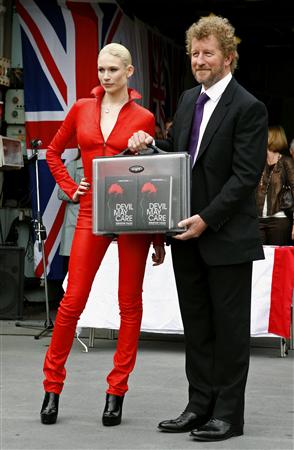
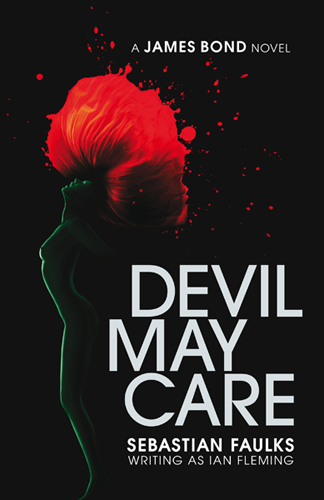
 Welcome Back, Mr. Bond
Welcome Back, Mr. Bond
Michael Maiello, "Forbes," 05.28.08, 12:01 AM ET
Happy 100th birthday, Ian Fleming. If James Bond's creator and the author of 14 Bond books were alive to read Devil May Care, he might well believe that he had written it. Sebastian Faulks, a celebrated author of literary fiction, went undercover "writing as Ian Fleming" and achieved a performance as remarkable as the one pulled off by his Bond girl, Scarlett Paplava, in the book.
Faulks sets his Bond story in 1967, after the events of The Man With the Golden Gun. It opens with Bond on an extended recuperative holiday. The gentleman spy is off liquor, women and violence, and has taken up tennis. He's trying to decide whether he'll return to the field or take a desk job with British intelligence.
The emergence of a new global super-villain forces Bond back into action. Pharmaceutical executive Julius Gorner turns poppies into morphine for use by hospitals throughout the world. He also manufactures heroin that he sends into the streets of London in the hopes that he can turn Britain into a cesspool of drug addiction.
Over decades, he believes, he can reduce Britain to Third World status, just punishment for the Crown's many sins during its age of empire. Gorner is quite obsessed with British history. When he has Bond in his clutches, he deliberately starves the spy because, he notes, that's what Britain did to Ireland during the potato famine.
Faulks gives Gorner a fantastic villain's defect: He was born with a monkey's paw. He's also impatient. Not content to beat Britain with cheap heroin, he has a plan to provoke a nuclear exchange between Britain and the Soviet Union, and Bond is Gorner's pawn in his game of atomic chess. Gorner also has a giant jet-powered hovercraft. Hovercrafts are cool.
Parisian investment banker Scarlett Paplava and her twin sister, Poppy, are Faulks' Bond girls. Poppy is Gorner's captive, and Paplava wants Bond to rescue her. She follows Bond to Iran in search of the kidnapper/drug kingpin. Bond quickly becomes infatuated with her, and fortunately for him, she's constantly losing some or most of her clothing. Faulks makes a running gag out of constant coitus interruptus between the two.
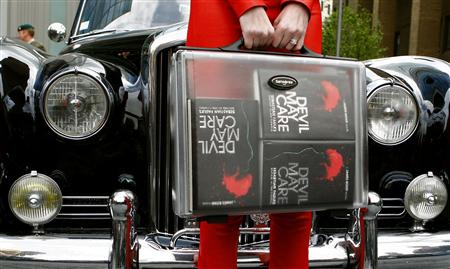 Bond is also aided by fellow spies from the Service and by American Felix Leiter, retired from the CIA and working as a Pinkerton's man in Hollywood. Leiter is missing a hand and leg that he lost while helping Bond fight off a hammerhead shark, but he doesn't let that slow him down.
Bond is also aided by fellow spies from the Service and by American Felix Leiter, retired from the CIA and working as a Pinkerton's man in Hollywood. Leiter is missing a hand and leg that he lost while helping Bond fight off a hammerhead shark, but he doesn't let that slow him down.
On his side, Gorner has a man named Chagrin, a sadist from Viet Nam who had his brain altered by Soviet surgeons so he can feel neither compassion nor pain. His specialty is removing people's teeth with pliers, but he also jabs chopsticks into a victim's ear and then boxes them upside the head, rupturing their eardrums.
Once the adventure gets going, it's as if Faulks, a fan of the Bond novels in his youth, got hold of his inner child, along with a bunch of action figures. Bond gets thrown from a jeep, nearly drowns in a well, finds himself in a gunfight on a nuclear-armed war plane set to obliterate Volgograd (Stalingrad) and then crash with all hands on board.
Not only can Bond survive all this but he does it while smoking an insane number of cigarettes after starting many of his days with bourbon and eggs for breakfast. Most mortals wouldn't be able to drag themselves into the office after a week of the James Bond diet, much less perform Olympian feats. But Bond's no mortal, and that's the fun of Devil May Care.
Unfortunately, the normally thoughtful Faulks gets a little careless with one character and plot point. J.D. Silver, an American spy in Tehran, Iran, turns out to be a double agent. Nothing wrong with that. Except for his motivation: He's being blackmailed because he's had some homosexual affairs. While people are blackmailed over sex all the time, it's unlikely, and maybe a bit irresponsible, to imply that some one would risk an all-out nuclear war just to keep his sexual identity closeted. The story is set 40 years ago, but to a reader in 2008 it seems a pretty thin rationale that's unintentionally offensive.
Everything else in Devil May Care is a delight. The over-the-top villain, the massive weapons, the grandiose plans and schemes, Bond's ability to bounce back from the most savage beatings, and the collisions and explosions are all on display. There's even some good combat advice: "Rather than cut the man's throat, Bond used the carotid takedown. Only eleven pounds of pressure to the carotid arteries is necessary to stop bloodflow to the brain and, once the flow has stopped, the average person loses consciousness within ten seconds." Have to keep that one in mind.
Well done, Mr. Faulks. It is indeed good to see Bond back.
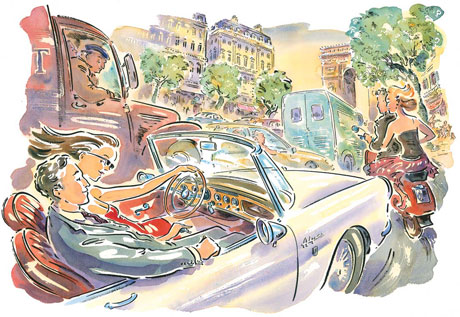
(Illustration from the Vanity Fair excerpt.)
|
MPS' 2008 SUMMER READS (from the BBC, Sunday, 10 August 2008 13:24)
Ffion Hague The Pain and the Privilege: The Women in Lloyd George's Life |
—Mark Lawson, "The Guardian"
"Classy pastiche."
—James Harker in The Guardian, Thursday 2 June 2011
"Faulks has not attempted to modernise Bond one whit. Instead he has carefully added a stylistically appropriate lean-to on the existing structure. Fleming died of heart failure in 1964. Faulks has imagined that ... he lived on to 1967 and wrote this one more book about his daydream hero"
—David Sexton, "London Evening Standard"
"Sorry to be so coarse, but is Bond now celibate? I only ask because I'm halfway through his latest adventure and he's barely had a snog."
—BBC
"Now that the James Bond movie franchise has been revitalized with a compelling new actor (Daniel Craig), it makes sense that Ian Fleming Productions would try to do the same thing with the 007 book business. The company hired an accomplished author of literary fiction, Sebastian Faulks, to get inside Fleming's skin and produce a secret-agent thriller true to the style of the man who defined the genre. The result, "Devil May Care," is a tale set in 1967 and finds Bond doing his thing in Rome, London, Paris, Iran and the Russian countryside. The book is well written, entertaining, passably authentic—and ultimately unsatisfying. ... 'Writing as Ian Fleming'—the phrase appears on the cover of the book, after Mr. Faulks's name—proves difficult. And is it really necessary? Better to find one of the original novels you may not have read, such as the book Mr. Faulks is most at pains to emulate, 'Moonraker.' After all, why order Freixenet when you can drink Bollinger?"
—Eric Felton, "Wall Street Journal"
Faulks, famous for Charlotte Gray and Birdsong, was not revealed to the public until July 2007, when a publishing date for the work was officially announced. It takes place in the time-frame of Fleming's original novels, the first such book since Amis' Colonel Sun (discounting the spin-off Young Bond and The Moneypenny Diaries lines). Faulks only agreed to one novel, however, as a one-off tribute. So despite massive sales (it was the fastest selling hardback in the company's history), Faulks said he was finished with Bond. Meanwhile, the existence of the continuation novels published between 1968 and 2008 (not counting the related Young Bond and Moneypenny Diaries series, which were ongoing) was underplayed by the press and publishers, and DMC was promoted as a direct continuation of Fleming's canon. As such, many media reports (such as, for example, the one posted by AOL Entertainment) made no reference to the work of Amis through Benson, stating outright that Devil May Care was the first new Bond novel since the 1960s. A similar error occurred in an Associated Press report on 8 January 2008 that stated only 13 post-Fleming novels had been published prior to Devil May Care.
On June 7, 2008, the London Times reported: "Devil May Care is the 33rd Bond book authorised by the author's estate since Ian Fleming's death in 1964 but the first since Kingsley Amis's Colonel Sun to be penned by an acclaimed literary novelist. Faulks is billed as the author, 'writing as Ian Fleming', and he has grandly explained that his commission was 'like asking someone who writes complex, symphonic music to write a pop song.'" That comment wasn't popular with fanboys, who attacked the whole thing as a parody instead of a tribute. The Times noted, "Fleming would have enjoyed the backlash immensely. He resented the snobbery of his wife Anne's literary friends and passed his work off as 'the pillow fantasies of an adolescent mind,' but he took himself seriously." Matthew Fleming, Ian's great-nephew and a member of Ian Fleming Publications' board, added: âWe couldn't be prouder of the job that Sebastian's done but we appreciate that there is a degree of public ownership of the Bond brand and everyone is entitled to their opinion."
But despite the complaints of betrayed fanboys, Devil May Care sold 44,093 copies in its first four days to top the Nielsen BookScan sales charts and become Penguin's fastest-selling hardback fiction title ever. And after DMC's release and massive success, another established author would be much easier to find...

"CARTE BLANCHE" BY JEFFERY DEAVER
See video coverage here
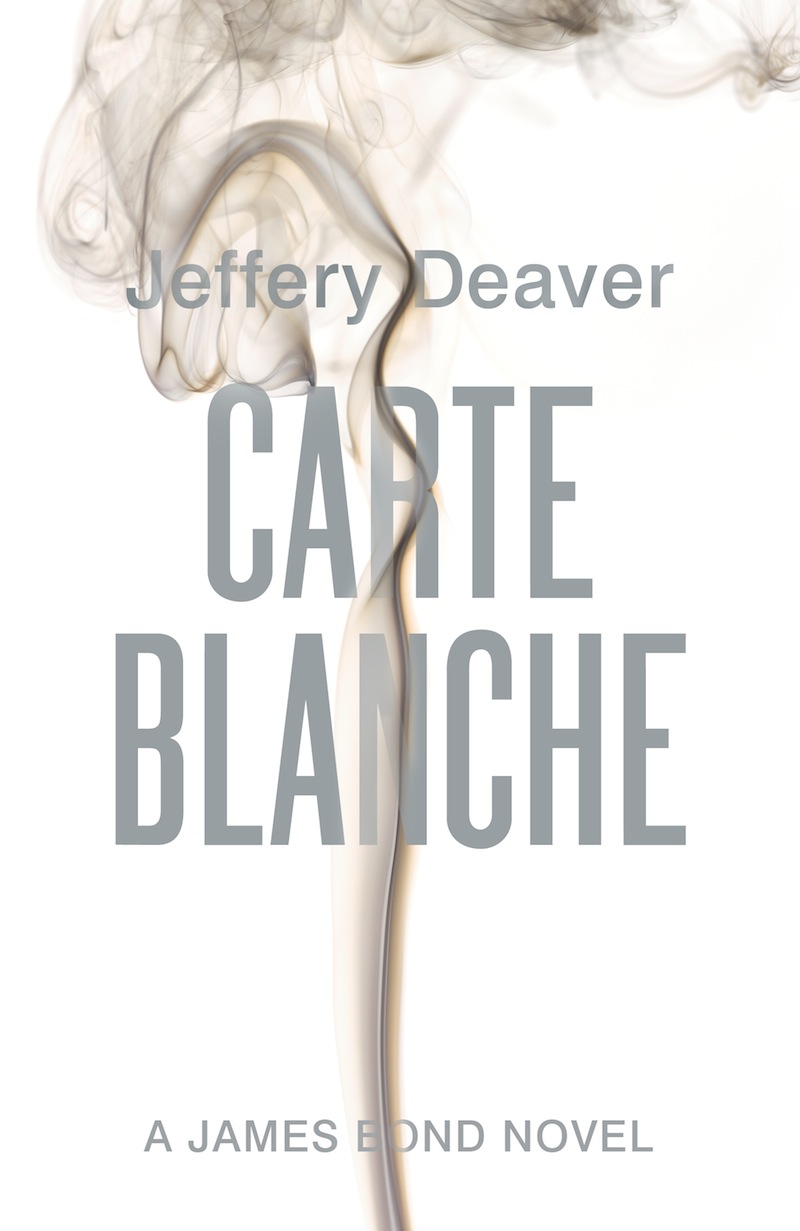 Faulks retired from Bond, and in 2011, Jeffery Deaver was commissioned by Ian Fleming Publications to re-boot the series.
Faulks retired from Bond, and in 2011, Jeffery Deaver was commissioned by Ian Fleming Publications to re-boot the series.
Deaver (born May 6, 1950) is an American mystery/crime writer. He originally started working as a journalist (like Fleming), but trained as a lawyer and later practiced law. He then became the author of twenty-seven novels (previous to his Bond duties). His The Bodies Left Behind was named Novel of the Year by the International Thriller Writers Association, and his Lincoln Rhyme thriller The Broken Window was also nominated for that prize. He has been awarded the Steel Dagger and Short Story Dagger from the British Crime Writers' Association and the Nero Wolfe Award, and he is a three-time recipient of the Ellery Queen Reader's Award for Best Short Story of the Year and a winner of the British Thumping Good Read Award. The Cold Moon was named the Book of the Year by the Mystery Writers Association of Japan, as well as by Kono Mystery Wa Sugoi magazine. In addition, the Japanese Adventure Fiction Association awarded the book their annual Grand Prix award. Deaver has been nominated for six Edgar Awards from the Mystery Writers of America, an Anthony Award and a Gumshoe Award. He was recently shortlisted for the ITV3 Crime Thriller Award for Best International Author. His book A Maiden's Grave was made into an HBO movie starring James Garner and Marlee Matlin. His novel The Bone Collector was a feature release from Universal Pictures, starring Denzel Washington and Angelina Jolie. His thriller, The Devil's Teardrop, was made into a TV movie by the Lifetime network, starring Natasha Henstridge, Tom Everett Scott, and Rena Sofer.
The title and cover artwork were unveiled on January 17, 2011, at a special launch event at the InterContinental Hotel in Dubai. The book itself was unveiled at an invite-only event at St. Pancras Station in London on 25th May 2011. Deaver made his grand entrance in a Carte Blanche labeled Bentley, accompanied by stunt woman, model and actress Chesca Miles. Royal Marine Commandos absailed from the roof of the elaborate station to hand Deaver a copy of the novel as he unveiled the book to the world's press.

 The thirty-seventh original James Bond novel, Carte Blanche was published in the United Kingdom by Hodder & Stoughton on 26 May 2011 and immediately became the country's top-seller. It was then released in the United States by Simon & Schuster on 14 June 2011. Carte Blanche is and the first to have a contemporary setting since The Man with the Red Tattoo by Raymond Benson was published in 2002. The novel updates James Bond's backstory to fit with the 21st century setting, making it the first ever reboot of the literary James Bond series. Deaver's James Bond was born in the early-1980s, a veteran of the wars in Afghanistan (Operation Herrick) and Iraq, instead of a World War II veteran and Cold War secret agent as originally conceived by Fleming.
The thirty-seventh original James Bond novel, Carte Blanche was published in the United Kingdom by Hodder & Stoughton on 26 May 2011 and immediately became the country's top-seller. It was then released in the United States by Simon & Schuster on 14 June 2011. Carte Blanche is and the first to have a contemporary setting since The Man with the Red Tattoo by Raymond Benson was published in 2002. The novel updates James Bond's backstory to fit with the 21st century setting, making it the first ever reboot of the literary James Bond series. Deaver's James Bond was born in the early-1980s, a veteran of the wars in Afghanistan (Operation Herrick) and Iraq, instead of a World War II veteran and Cold War secret agent as originally conceived by Fleming.
"He simply knocks five decades off the ages of 007's old posse and presents them as they were introduced in the 1950s, their distinctive characters pleasingly intact. Rebooted here as an Afghanistan veteran, Bond is more love-lorn metrosexual than opportunist seducer but he sports a Rolex, dresses flashily and drives a Bentley Continental GT—a footballer's car but faithful to Fleming's 007 whose Continental was pimped beyond recognition."
—Jeremy Jehu of The Telegraph
"Fleming's Bond was not much of a comedian, and Deaver's isn't either. The difference is that he tries to be. 'Upscale pubs were more ghastly than gastro, he'd once quipped.' Perhaps it's the nicotine withdrawal. Bond does have a usefully named secretary to whom he can say 'Good morning, Goodnight', but the best comic effects derive from the style's fanatical commitment to elegant variation. When Bond thoughtfully studies a bullet, subsequent reference to the bullet cannot call it a bullet again; it must be 'the solid piece of ammunition'. If Bond 'whisks' a woman's dress off, subsequent reference to the dress cannot call it a dress again; it must be 'the insubstantial blue cloth'. And if Bond scrambles some eggs, subsequent reference to the eggs cannot call them eggs again; they must be 'steaming curds'. That image is a poetic, almost alchemical transformation, and in a way Deaver has accomplished the same feat with his novel as a whole: taking the nutritious egg of the Bond mythos and turning it into one giant steaming curd."
—Steven Poole, Guardian.co.uk, Thursday 26 May 2011
"Deaver says he has always been a devoted Bond fan. What thriller writer isn't? Fleming was a master of succinct plotting and deft characterisation, his books deceptively slim but containing so much. Deaver too is a genius and this publishing marriage was truly made in heaven. Bond fans will enjoy Deaver's slightly mischievous take on Ian Fleming. Deaver fans will enjoy the taut plotting and the action scenes and, by the way, it is going to make a great movie."
—Jennifer Selway, Daily Express, 27 May 2011
"...The most impressive feature of Carte Blanche is the ingenuity of the breathless, blood-thirsty plot. A master of misdirection, Deaver manufactures more surprises than anyone flogging an old warhorse can be expected to produce. And his portrait of a thirtysomething Bond, dreading that his father may have been a double agent, adds depth to a man who is essentially a lonely predator. A couple of arched eyebrows suggest Deaver had Roger Moore in mind. One hopes not: Daniel Craig hasn't felt the need, so far, to camp it up. Kingsley Amis, John Gardner and Sebastian Faulks are among those who have tried to bring Bond back to life. Deaver, though, is in a class of his own: nobody's done it better."
—Mark Sanderson of The Evening Standard, 26 May 2011
"SOLO" BY WILLIAM BOYD
See video coverage here
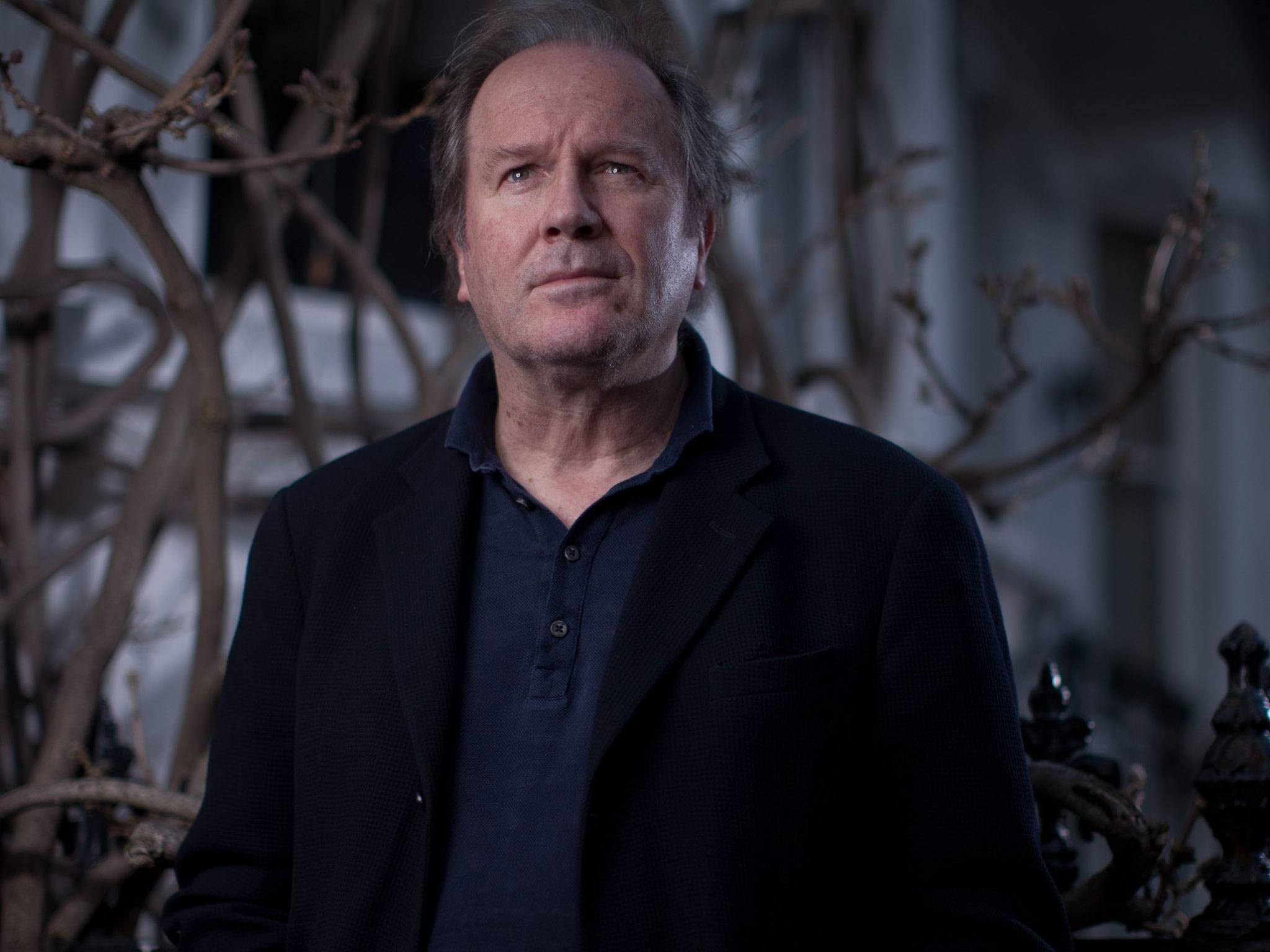
"CARTE BLANCHE" BY JEFFERY DEAVER
 Faulks retired from Bond, and in 2011, Jeffery Deaver was commissioned by Ian Fleming Publications to re-boot the series.
Faulks retired from Bond, and in 2011, Jeffery Deaver was commissioned by Ian Fleming Publications to re-boot the series.
Deaver (born May 6, 1950) is an American mystery/crime writer. He originally started working as a journalist (like Fleming), but trained as a lawyer and later practiced law. He then became the author of twenty-seven novels (previous to his Bond duties). His The Bodies Left Behind was named Novel of the Year by the International Thriller Writers Association, and his Lincoln Rhyme thriller The Broken Window was also nominated for that prize. He has been awarded the Steel Dagger and Short Story Dagger from the British Crime Writers' Association and the Nero Wolfe Award, and he is a three-time recipient of the Ellery Queen Reader's Award for Best Short Story of the Year and a winner of the British Thumping Good Read Award. The Cold Moon was named the Book of the Year by the Mystery Writers Association of Japan, as well as by Kono Mystery Wa Sugoi magazine. In addition, the Japanese Adventure Fiction Association awarded the book their annual Grand Prix award. Deaver has been nominated for six Edgar Awards from the Mystery Writers of America, an Anthony Award and a Gumshoe Award. He was recently shortlisted for the ITV3 Crime Thriller Award for Best International Author. His book A Maiden's Grave was made into an HBO movie starring James Garner and Marlee Matlin. His novel The Bone Collector was a feature release from Universal Pictures, starring Denzel Washington and Angelina Jolie. His thriller, The Devil's Teardrop, was made into a TV movie by the Lifetime network, starring Natasha Henstridge, Tom Everett Scott, and Rena Sofer.
The title and cover artwork were unveiled on January 17, 2011, at a special launch event at the InterContinental Hotel in Dubai. The book itself was unveiled at an invite-only event at St. Pancras Station in London on 25th May 2011. Deaver made his grand entrance in a Carte Blanche labeled Bentley, accompanied by stunt woman, model and actress Chesca Miles. Royal Marine Commandos absailed from the roof of the elaborate station to hand Deaver a copy of the novel as he unveiled the book to the world's press.

 The thirty-seventh original James Bond novel, Carte Blanche was published in the United Kingdom by Hodder & Stoughton on 26 May 2011 and immediately became the country's top-seller. It was then released in the United States by Simon & Schuster on 14 June 2011. Carte Blanche is and the first to have a contemporary setting since The Man with the Red Tattoo by Raymond Benson was published in 2002. The novel updates James Bond's backstory to fit with the 21st century setting, making it the first ever reboot of the literary James Bond series. Deaver's James Bond was born in the early-1980s, a veteran of the wars in Afghanistan (Operation Herrick) and Iraq, instead of a World War II veteran and Cold War secret agent as originally conceived by Fleming.
The thirty-seventh original James Bond novel, Carte Blanche was published in the United Kingdom by Hodder & Stoughton on 26 May 2011 and immediately became the country's top-seller. It was then released in the United States by Simon & Schuster on 14 June 2011. Carte Blanche is and the first to have a contemporary setting since The Man with the Red Tattoo by Raymond Benson was published in 2002. The novel updates James Bond's backstory to fit with the 21st century setting, making it the first ever reboot of the literary James Bond series. Deaver's James Bond was born in the early-1980s, a veteran of the wars in Afghanistan (Operation Herrick) and Iraq, instead of a World War II veteran and Cold War secret agent as originally conceived by Fleming.
"He simply knocks five decades off the ages of 007's old posse and presents them as they were introduced in the 1950s, their distinctive characters pleasingly intact. Rebooted here as an Afghanistan veteran, Bond is more love-lorn metrosexual than opportunist seducer but he sports a Rolex, dresses flashily and drives a Bentley Continental GT—a footballer's car but faithful to Fleming's 007 whose Continental was pimped beyond recognition."
—Jeremy Jehu of The Telegraph
"Fleming's Bond was not much of a comedian, and Deaver's isn't either. The difference is that he tries to be. 'Upscale pubs were more ghastly than gastro, he'd once quipped.' Perhaps it's the nicotine withdrawal. Bond does have a usefully named secretary to whom he can say 'Good morning, Goodnight', but the best comic effects derive from the style's fanatical commitment to elegant variation. When Bond thoughtfully studies a bullet, subsequent reference to the bullet cannot call it a bullet again; it must be 'the solid piece of ammunition'. If Bond 'whisks' a woman's dress off, subsequent reference to the dress cannot call it a dress again; it must be 'the insubstantial blue cloth'. And if Bond scrambles some eggs, subsequent reference to the eggs cannot call them eggs again; they must be 'steaming curds'. That image is a poetic, almost alchemical transformation, and in a way Deaver has accomplished the same feat with his novel as a whole: taking the nutritious egg of the Bond mythos and turning it into one giant steaming curd."
—Steven Poole, Guardian.co.uk, Thursday 26 May 2011
"Deaver says he has always been a devoted Bond fan. What thriller writer isn't? Fleming was a master of succinct plotting and deft characterisation, his books deceptively slim but containing so much. Deaver too is a genius and this publishing marriage was truly made in heaven. Bond fans will enjoy Deaver's slightly mischievous take on Ian Fleming. Deaver fans will enjoy the taut plotting and the action scenes and, by the way, it is going to make a great movie."
—Jennifer Selway, Daily Express, 27 May 2011
"...The most impressive feature of Carte Blanche is the ingenuity of the breathless, blood-thirsty plot. A master of misdirection, Deaver manufactures more surprises than anyone flogging an old warhorse can be expected to produce. And his portrait of a thirtysomething Bond, dreading that his father may have been a double agent, adds depth to a man who is essentially a lonely predator. A couple of arched eyebrows suggest Deaver had Roger Moore in mind. One hopes not: Daniel Craig hasn't felt the need, so far, to camp it up. Kingsley Amis, John Gardner and Sebastian Faulks are among those who have tried to bring Bond back to life. Deaver, though, is in a class of his own: nobody's done it better."
—Mark Sanderson of The Evening Standard, 26 May 2011
"SOLO" BY WILLIAM BOYD

William Boyd: The man who knows the real 007
The writer has been doing research for a novel about a 'complex, troubled Bond'. And he knows how to keep his cards close to his chest. Susie Mesure meets William Boyd
by Susie Mesure, The Independent, Sunday, 16 Dec 2012
For such an expansive chap, William Boyd is being annoyingly evasive. I'm digging for a titbit about his latest novel, a new James Bond book, but the prolific novelist is playing his cards closer to his chest than the secret agent himself. I have, I realise, gone about this interview all wrong. We're sitting in the upstairs living room of Boyd's Chelsea townhouse. I'd hoped the cosy setting, which has the unlikely feel of a French farmhouse-cum-second-hand-bookstore, might trigger a few indiscretions about the spy's next adventure. But no.It turns out I should have pressed him to meet at London's Dukes Hotel, Ian Fleming's old watering hole, over a Vesper or three for lubrication purposes. The "mind-bogglingly strong" cocktail Ð three parts gin, one part vodka, half part Lillet, with a dash of Angostura bitters, and a slice of orange peel Ð was a Bond invention, named after one of the secret agent's many women, which Boyd drank "in the interests of research" at the hotel's legendary bar.
"It's rocket fuel. And it all comes from the freezer, so it's icy cold and not diluted at all by ice chips. I had one, and thought..." He trails off, presumably unable to remember much else. Curses!
The meticulous writer cuts a vaguely raffish air in his open-neck, chambray shirt, worn untucked over navy chinos with some sockless tan boatshoes, a single, silver bangle on his wrist, and the signs of an old earring hole visible in his left ear. He clearly had a field day researching the literary Bond, "a far more interesting character than the cinematic one by enormous degrees".
This seems largely to have involved totting up the vast number of alcoholic drinks sunk by the spy, a reflection, Boyd adds, of Fleming's hedonistic life. "He [Fleming] was obsessed with food, obsessed with drink, and clothes, and cars. He gives these personal obsessions to Bond... I've been counting his drinks through the books, which has been great fun, because Fleming obviously hadn't realised how many double bourbon on the rocks he had drunk."
The "troubled, complex" James Bond is the one we will read about when Boyd's book is published next autumn. Era-wise, Boyd has dived back into Fleming's world, setting his story in 1969, five years after Fleming released his last work, The Man with the Golden Gun. Forced to jump to my own conclusions, I'm betting the action takes our hero to Africa, scene of both Boyd's formative years and his early books such as An Ice-Cream War; A Good Man in Africa; and Brazzaville Beach.
For the record, I'm basing my assumption on the wry smile Boyd gives when I ask if he's planning to set another novel in Africa. "I may well do, I may well do," the 60-year-old says in his softly Scottish accent. It's been years, decades even, since Boyd journeyed there, literarily and literally. He says Africa Ð he was born in Ghana and lived in Nigeria until his late teens Ð yields the "pure source of memories" he uses as a writer, and another reason that I'm guessing he might draw on that continent for Bond's adventures.
"As a novelist, where do you go to tap into memories, and impressions, and sensations? It's usually, in my experience, your early life, before you started thinking of yourself as a writer, because somehow those experiences are unadulterated. When you reach that moment, all experience is filtered, not immediately but eventually, by the writer's brain."
As a teenager, he bounced between western Nigeria, where his father worked as a doctor and his mother taught, and Scotland: he went to the notoriously tough boarding school Gordonstoun. Not that he thinks of himself as particularly Scottish, despite originally hailing from Fife. "I don't really know where I'm from. Is home wherever I hang my hat? Or are you just a deracinated mixture of all the influences that have come your way?" he asks, when I quiz him. "It's one of the things I often ask myself. I think it's why I write about identity so much. It's strange; when I was younger and people would ask, 'Where are you from?', I'd say, 'West Africa', which was odd because I'm obviously not African, but it was my home. I've lived in England, in Oxford and London, ever since [school and university]. But I also have a house in France, where I feel very at home as well."
All this talk of identity brings us to Restless, Boyd's popular spy novel, and arguably his most populist, being, as it was, a "Richard and Judy" choice in 2007 and winning the high-profile Costa Award. The author has dramatised his novel for a BBC double-bill, which airs over two evenings after Christmas. It's gripping stuff. I've seen it, with a Christmas cracker of a cast, ranging from the inimitable Charlotte Rampling and Michael Gambon to TV's new favourite Michelle Dockery (Lady Mary in Downton Abbey) and Hayley Atwell, who also starred in his adaptation of another of his novels, Any Human Heart.
Boyd, who is sitting on a sofa across from me, uncrosses his legs and leans forward in enthusiasm, professing himself "dead chuffed" with his latest television version. He has, he says somewhat defensively, "no snobbism at all" about writing for the small screen. "In some ways, you could argue, television is doing far more interesting work than the movies. It's more fulfilling. Characters can do more and you don't have to cut, cut, cut."
I'm struck, listening to Boyd, who is astonishingly free of ego for one so successful, by how hard he works. He claims he's no "Stakhanovite kind of manic", but then tells me he wrote for six newspapers in a single day just the other week. "To live as an artist requires hard work or some extraordinary good fortune to come your way. Don't get complacent."
Restless, which jumps between the early Forties and 1976, was the first of what Boyd says wound up being a trilogy of spy novels, including Ordinary Thunderstorms and his most recent, Waiting for Sunrise. Despite his "Kim Philby obsession", he says he's somewhat spied out narratively speaking, so expect a genre shift for his next book. Before that, Boyd obsessives Ð of whom there are clearly countless thousands; never have so many people asked me for an autograph from an interviewee Ð have a different sort of literary treat in store: his first play.
Rehearsals for Longing, which Boyd based on two Chekhov short stories, start next month, but as of Friday was still being cast. "It opens on 7 March Ð which is my birthday Ð which I'm hoping is a good omen, not a bad omen." This latest venture rekindles something of an old flame for Boyd who was theatre critic for his university magazine at Glasgow in the 1970s. "A lot of my friends are actors and I've always been stage stuck. Forty years later I've finally managed to get this monkey off my back," he adds.
Whether the reviews are good or bad, you can expect the evasive Boyd to avoid attempts to make him blow his own trumpet. When prompted to share one of his secrets, something of a theme in Restless, all he'd say was: "The very last thing you know about yourself is your effect. This is a secret that applies to everyone."
Part one of Boyd's adaptation of 'Reckless' airs on BBC1 on 27 December
Curriculum vitae
1952 Born 7 March in Accra, Ghana, where his father works as a doctor and his mother is a teacher. Moves to western Nigeria with his parents and two younger sisters after Ghana becomes independent. As a teenager he travels between Ibadan and northern Scotland where he boards at Gordonstoun. Reads English at the University of Glasgow, where he meets his eventual wife, Susan.
1980 Becomes a lecturer at St Hilda's College, Oxford, and writes his first novel, A Good Man in Africa. Wins the Whitbread First Novel Award.
1982 His second, An Ice-Cream War, is shortlisted for the then Booker prize.
1998 Famously hoaxes the art world with the fictional Nat Tate, about whom he wrote a biography.
2005 Awarded a CBE.
2006 Restless wins the Costa Book Award.
2012 Adapts Any Human Heart for Channel 4 mini-series.
2012 The Ian Fleming estate asks him to write a new James Bond novel.
"William Boyd on debut play Longing - and why Daniel Craig isn't right for his James Bond" by Matilda Battersby; The Independent, 27 Feb 2013.
"Indicating with an uncomfortable glance at the window that snipers might
be trailing us from across the street Boyd gives a wry laugh. He tells me there
is a joined up 007 PR machine covering both the film and publishing empire that
'has begun the drip-feed of information' that he can't interfere with. But he is
clear about one thing: his novel is not being lined up as the basis for a
follow-up to Skyfall, the most successful Bond film to date having taken
a record £100m at the UK box office, or any other of the spy movies. "I don't
think they'll ever make a retro Bond. Even Dr No which was written in
1955 was set in 1962 when the film was made. All the Bond films from then have
been completely contemporary. They wouldn't go back and make a Bond set in
1969. It would throw the whole franchise askew,' he said. This is a
great shame as Daniel Craig, whom Boyd is friends with, will be 45 in March,
the exact age of Boyd's Bond who follows Fleming's detailed chronology. Much as
we might love a period drama it wouldn't make sense to cast Craig back, Life
On Mars-style, five decades, Boyd insists mentioning the gadgets, cars and
styles of the day that have come to define each cinematic instalment. But, he
concedes: 'It's interesting in Skyfall to see them referring back, as it
were, to Bond's biography, but of course it is set in 2012 so Bond would have
been 88. In a way I have the easier, or more logical, task, because my Bond is
living his history. His schooldays, his parenting and upbringing is all there... There is a
disconnect between the film Bond and the literary Bond which is their
contemporaneity. I don't suffer from that.'"
A FINAL CHAPTER?
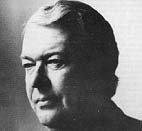 "... That reminds me of an idea for a short story I had that would round out the whole saga. It was the kind of story you put in a Christmas annual. This is the aged Commander Bond, age 70 probably, on holiday in Switzerland. He doesn't ski anymore. A very beautiful young girl, whose father is a United States senator, comes up to him and says, "My father is in danger. Sinister Colonel-General Moriarvsky of the KGB has kidnapped him. Please help me. You're the only person I can ask. And I'll do anything if you help me." So Bond says, "Well, it's a bit late for anything... BUT... I'll help you." And of course, at the end the Russian General and Commander Bond are falling over a waterfall in eachother's arms. When I told this to Glidrose, they all went white! (In a slow, menacing whisper.) "Don't you dare write this! Not a word of it!"
"... That reminds me of an idea for a short story I had that would round out the whole saga. It was the kind of story you put in a Christmas annual. This is the aged Commander Bond, age 70 probably, on holiday in Switzerland. He doesn't ski anymore. A very beautiful young girl, whose father is a United States senator, comes up to him and says, "My father is in danger. Sinister Colonel-General Moriarvsky of the KGB has kidnapped him. Please help me. You're the only person I can ask. And I'll do anything if you help me." So Bond says, "Well, it's a bit late for anything... BUT... I'll help you." And of course, at the end the Russian General and Commander Bond are falling over a waterfall in eachother's arms. When I told this to Glidrose, they all went white! (In a slow, menacing whisper.) "Don't you dare write this! Not a word of it!"
—Kingsley Amis, Bondage #13, 1984


¹—"Lucy Fleming on James Bond's anniversary, her uncle's legacy and die-hard fans", by Oliver Franklin. British GQ. 03 October 2012.

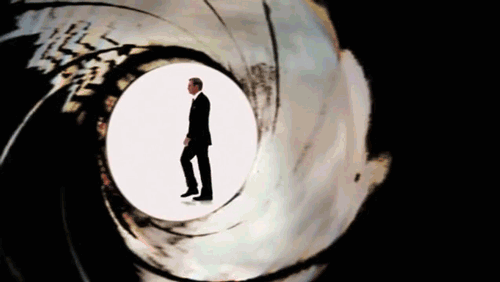

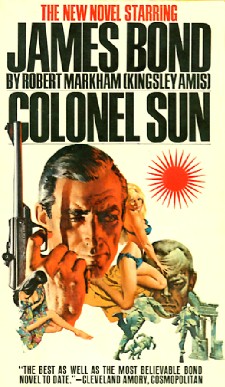
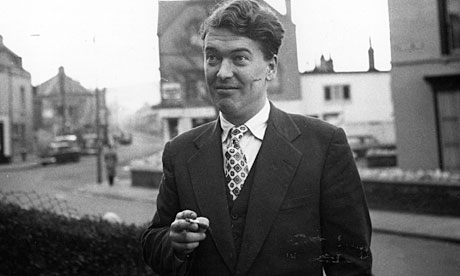 "Good dirty fun."
"Good dirty fun."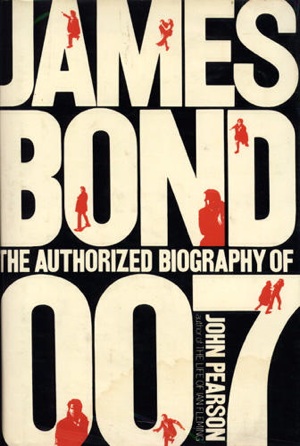 Sidgwick & Jackson (UK) and William and Morrow Co. (USA)
Sidgwick & Jackson (UK) and William and Morrow Co. (USA) 
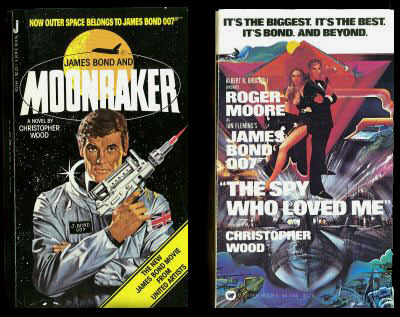 In 1977, the film The Spy Who Loved Me was released and, due to the radical differences between the film and the original novel of the same name, Glidrose authorised a novelization, James Bond, The Spy Who Loved Me, written by screenwriter Christopher Wood (published 1977 in London by Jonathan Cape; Wraparound jacket artwork by Bill Botten). The novelization and the screenplay are somewhat different, however. In the novelisation SMERSH is still active and still after James Bond. Their part in the novelization begins during the "pre-title credits" sequence in which Bond is escaping from a cabin on the top of Aiguille du Mort, a mountain near the town of Chamonix. After the mysterious death of Fekkish, SMERSH appears yet again, this time capturing and torturing Bond for the whereabouts of the microfilm that retains plans for a submarine tracking system (Bond escapes after killing two of the interrogators). The appearance of SMERSH conflicts with a number of Bond stories, including the film The Living Daylights (1987), in which a character remarks that SMERSH has been defunct for over 20 years. It also differs from the latter half of Fleming's Bond novels in which SMERSH is mentioned to have been put out of operation. Members of SMERSH from the novelization include the Bond girl Anya Amasova and her lover Sergei Borzov as well as Colonel-General Niktin, a character from Fleming's novel From Russia, with Love who has since become the head of SMERSH. Other differences:
In 1977, the film The Spy Who Loved Me was released and, due to the radical differences between the film and the original novel of the same name, Glidrose authorised a novelization, James Bond, The Spy Who Loved Me, written by screenwriter Christopher Wood (published 1977 in London by Jonathan Cape; Wraparound jacket artwork by Bill Botten). The novelization and the screenplay are somewhat different, however. In the novelisation SMERSH is still active and still after James Bond. Their part in the novelization begins during the "pre-title credits" sequence in which Bond is escaping from a cabin on the top of Aiguille du Mort, a mountain near the town of Chamonix. After the mysterious death of Fekkish, SMERSH appears yet again, this time capturing and torturing Bond for the whereabouts of the microfilm that retains plans for a submarine tracking system (Bond escapes after killing two of the interrogators). The appearance of SMERSH conflicts with a number of Bond stories, including the film The Living Daylights (1987), in which a character remarks that SMERSH has been defunct for over 20 years. It also differs from the latter half of Fleming's Bond novels in which SMERSH is mentioned to have been put out of operation. Members of SMERSH from the novelization include the Bond girl Anya Amasova and her lover Sergei Borzov as well as Colonel-General Niktin, a character from Fleming's novel From Russia, with Love who has since become the head of SMERSH. Other differences: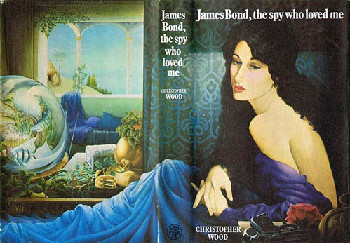 Novelization: The villain is Sigmund Stromberg.
Novelization: The villain is Sigmund Stromberg.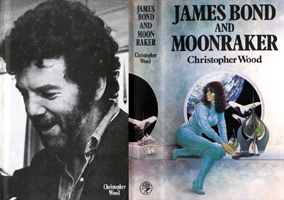 The 1979 film Moonraker was also novelized, as James Bond and Moonraker (published 1979 by Jonathan Cape; Wraparound jacket artwork by Bill Botten). Unlike Wood's first novelization, he writes a virtually direct novelization of the screenplay. The only noticeable differences between the novelization and the screenplay for Moonraker is that there is no mention of Dolly, Jaws' girlfriend, and his characterization stays true to Wood's description as being a mute. In addition, at the conclusion of the Venetian canal chase sequence, Bond's gondola does not sprout a flotation device and ascend to St. Mark's square as it does in the film.
The 1979 film Moonraker was also novelized, as James Bond and Moonraker (published 1979 by Jonathan Cape; Wraparound jacket artwork by Bill Botten). Unlike Wood's first novelization, he writes a virtually direct novelization of the screenplay. The only noticeable differences between the novelization and the screenplay for Moonraker is that there is no mention of Dolly, Jaws' girlfriend, and his characterization stays true to Wood's description as being a mute. In addition, at the conclusion of the Venetian canal chase sequence, Bond's gondola does not sprout a flotation device and ascend to St. Mark's square as it does in the film. 
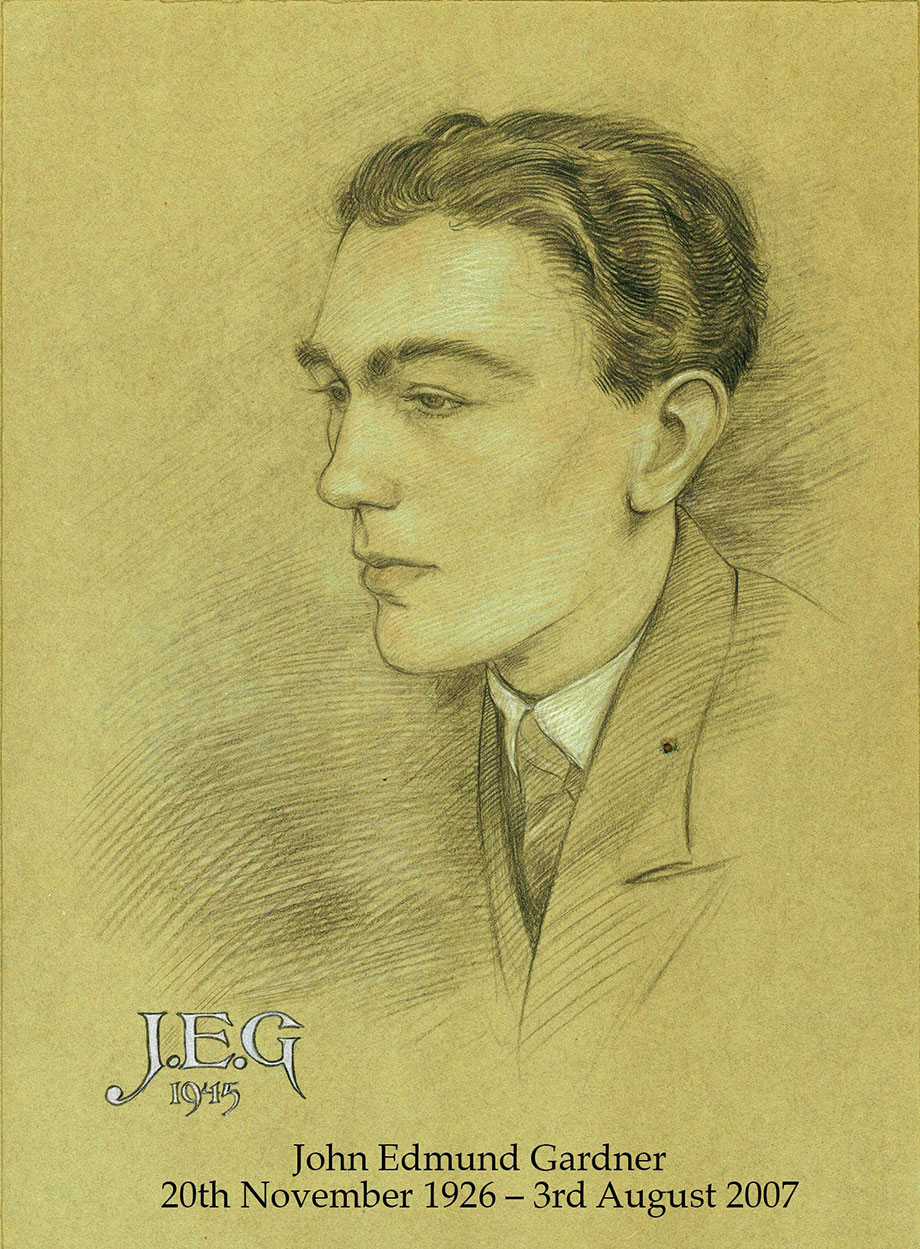 John Edmund Gardner (20 November 1926 - 3 August 2007) began his novelist career with The Liquidator, in which he created the character named Boysie Oakes who inadvertently is mistaken to be a tough, pitiless man of action and is thereupon recruited into a British spy agency. Oakes is, in actuality, a devout coward. The book was made into a movie by MGM of the same title, and another seven light-hearted novels about the cowardly Oakes appeared over the next 12 years.
John Edmund Gardner (20 November 1926 - 3 August 2007) began his novelist career with The Liquidator, in which he created the character named Boysie Oakes who inadvertently is mistaken to be a tough, pitiless man of action and is thereupon recruited into a British spy agency. Oakes is, in actuality, a devout coward. The book was made into a movie by MGM of the same title, and another seven light-hearted novels about the cowardly Oakes appeared over the next 12 years. 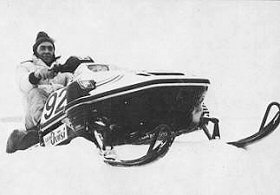 "I'm always conscious when I'm doing Bond that he is not mine. I have to keep a slight distance from him because he is somebody else's creation, and not my own."
"I'm always conscious when I'm doing Bond that he is not mine. I have to keep a slight distance from him because he is somebody else's creation, and not my own."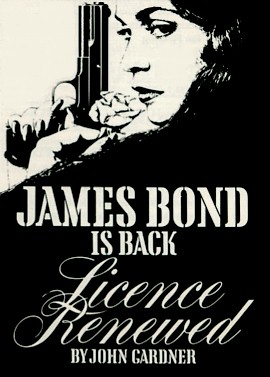 JOHN GARDNER RESPONDS TO KINGSLEY AMIS:
JOHN GARDNER RESPONDS TO KINGSLEY AMIS: